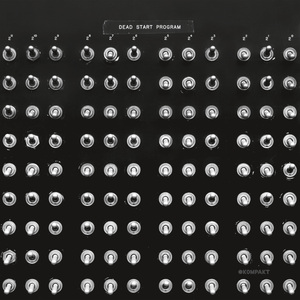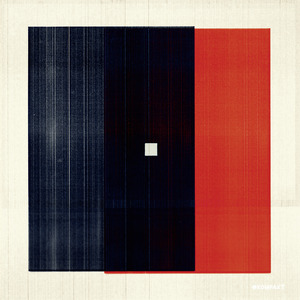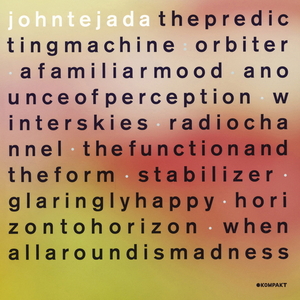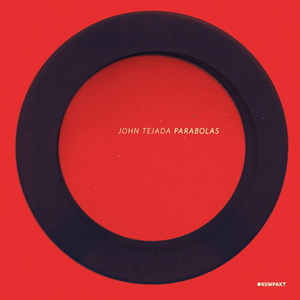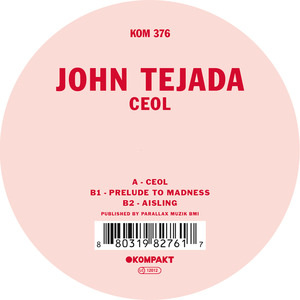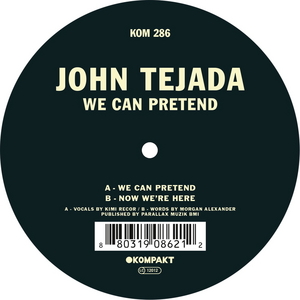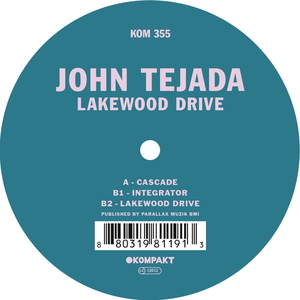Studio equipment
Our full range of studio equipment from all the leading equipment and software brands. Guaranteed fast delivery and low prices.
DJ equipment
Our full range of DJ equipment from all the leading equipment and software brands. Guaranteed fast delivery and low prices. Visit Juno DJ
JOHN TEJADA Q&A
With both of your parents being into music, sure you have been immersed into music since an early age, but when and how did you get into the music scene, DJing and producing?
The one thing I’ll say about the early influence is that it made music actually seem like something people do when they grow up, which had a lasting impact.
I discovered DJ mixes on the radio pretty young. Around age 10 or 11. This was all on KDAY here a local hip hop station that would also mix in lots of NYC and LA electro and electronic sounds. First I wanted to know how to mix music together, so not long after I was able to get a cheap pair of Realistic decks and mixer. I kept at DJ’ing and around age 16 I now wanted to know what these sounds were and how this music was put together. I started then with some looper pedals and a 4 track cassette. At the age of 17 in bought my first sampler, an Ensoniq EPS from DJ Numark. Soon after a Casio CZ101. This was 1991. I also met my longest collaborator Arian Leviste then. He had a Juno 106, TR-909 and some other bits and we put our stuff together and just made music all the time. I’d make loads more music solo as well. At the time I was actually doing a Hip Hop radio show on KCSN (CSUN in Northridge) with 3 other guys. It took another 3 years before we could figure out how to try to release some music. Pre-internet for us and you had to mail cassettes etc. Different times! We finally pressed up our own little single and soon after I started sending tapes out to record labels that I had records of in my bag. A13, Multiplex, Generations R&S were some of the first that picked up my music. More releases slowly spread the word and I was finally doing some shows with my first UK appearance in 97. I just kept at it and here we are.
What do you personally consider to be the key moments in your artistic career?
This is a tough one as while they’re happening they seem distant and then looking back I feel like I don’t exactly relive them in my mind as they were. For me, key moments would be personal connections I’ve made. If I think about it, probably everyone close to me I’ve met through music and because I do music. My best friends and all my musical collaborators, my wife. It’s wild to think I may not know any of these people that are so important to me if I wasn’t doing music. Playing the Walt Disney Concert Hall a couple of times were great moments for me. “The End Of It All” connecting so strongly in 2006 was also an encouraging moment. Getting picked up by A13 in 96 to do my first couple of albums. Linking up with Kompakt in 2011 which has given me a lot of freedom to explore in a broader way artistically. And perhaps this week, playing my first 2 shows with friend and collaborator Reggie Watts as Wajatta.
“Dead Start Program” is your fourth album with Kompakt, what’s been the starting point to your collaboration with Kompakt? How and where did you guys meet?
We would have met here and there as I started DJing in Germany and around Europe around 2000 or so. However, I finally linked up with Kompakt to do a remix for Gui Boratto “Take My Breath Away” in 2009. In 2011 I was all set to release Parabolas on Palette and the distribution I was with at the time fell apart. Without knowing my next step my good friend Jimmy Tamborello (Dntel) said when listening to it “This would be good on Kompakt.” I thought yeah what a good idea and I then remembered how smooth the Boratto remix project went. I emailed Michael with a link and 2 days later I got email saying “Don’t play this for anyone else, you have a home on Kompakt.”
What is your approach when you start on a project at such an album? How did the production of “Dead Start Program” go?
Usually when making an album, I don’t realize I’m making one till I’m about half way through. This is usually because I’m trying out some new techniques that might be a bit foreign to me and it takes a while to see if it’s working or not. This usually comes together after a few songs and I’ll realize I have sort of a theme going on that I can further develop. However this time, I felt I had an album in me but the fact it wasn’t actually existing became frustrating, so I actually made a conscious effort to work quite diligently on a new full length. Production wise I kept it fairly simple which helps me get things done. I mostly used a couple of polysynths, the Modor NF1 and DSI OB-6. More on the DAWs used in a question below.
A quick word about “Dead Start Program” title and artwork please? And while we are talking about music program, what piece of software and hardware you are using the most?
I was gifted a print of an analog computer by my wife with the words “Dead Start Program” taped over the top. This is an image from the Computer History Museum in Mountain View California. It hung in our hallway for a few years and even though I really liked it, I always preferred original design for my covers. However all of a sudden I just felt like this was exactly what I wanted for the new record and we figured out how to get license of the image and it worked out. The image itself is an analog boot up process for an old CDC6600 computer. However the words and the image was always striking to me and began to take on multiple meanings. I feel that’s the case with all the titles I choose for albums. They can be literally quite simple but playing with the words can come up with alternate ideas and meanings.
Software wise along with my hardware synths which are 95% of my sound sources, I used a combo of Logic Pro, Renoise and Ableton. The track Autoseek references Renoise’s autoseek feature option on long samples. I really like using a variety of DAWs as they each inspire me slightly differently. And at the moment Bitwig 2.3 is a big bowl of excitement.
Hardware I’ve got a collection of a bit of Eurorack, still have my classic Roland’s although not used a ton anymore. I prefer to sample them and process them. All the Elektrons which are great for live shows. The Monomachine MK2 is a real classic for me that I still use in lots of songs. I’ve got a Dave Smith OB-6 I really enjoy. I’m quite excited for the Elektron Digitone which I haven’t got my hands on yet.
How do you prepare before a DJ set? What are the elements that make you decide to play a particular track during one of your sets?
I mostly just prepare by listening and picking music. I don’t like to overwhelm myself with too many selection choices. Even when working with digital formats, I still prefer to limit it to the amount of tracks I would have if I brought my record bag. I generally compile some current and older favorites and generally just work with that. So in a way I’m choosing almost every track that must get played that night since I have a limited amount of titles. I guess this goes back to my old school ways of not being able to bring limitless music with me. I had to make decisions about what fit in the record bag. I still like this way of looking at it. I get too lost having different playlists etc. It’s overwhelming.
There's a lot of hype around Los Angeles at present, with your hometown being hailed as the new emerging capital of electronic music. But to those in the know, L.A's always had a strong underground scene and both you and your wife have been strongly involved within it for over two decades. What are your predictions for Fair city's scene moving forward?
Yes, things have been changing at a rapid pace especially in the last 4 years or so. I’ve always felt LA deserved to have a much much larger music scene so its great that its now happening. I feel at its core here the underground scene is where the real stuff is. That is what Angelenos tend to want to follow. No one here likes a velvet rope or unfriendly staff which is what happens with most of the “clubs.” I think because of this, the underground scene here will stay pretty real for quite some time as the money making stuff moves over to these bigger and not so fun venues.
Any tips on which label, DJ and/or producer to look at for 2018?
I disappointingly don’t have any exciting tips on upcoming new producers. I do still buy lots of vinyl only releases but many are anonymous etc. So generally a lot of interesting finds are sort of one offs and hard to follow. I’m generally a fan of my close friends and collaborators. I know Plaid have some exciting things in the works, as well as Silent Servant, Dntel and Natan H.
Read more...



